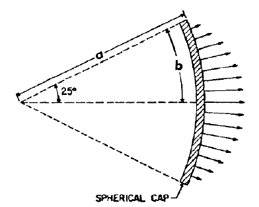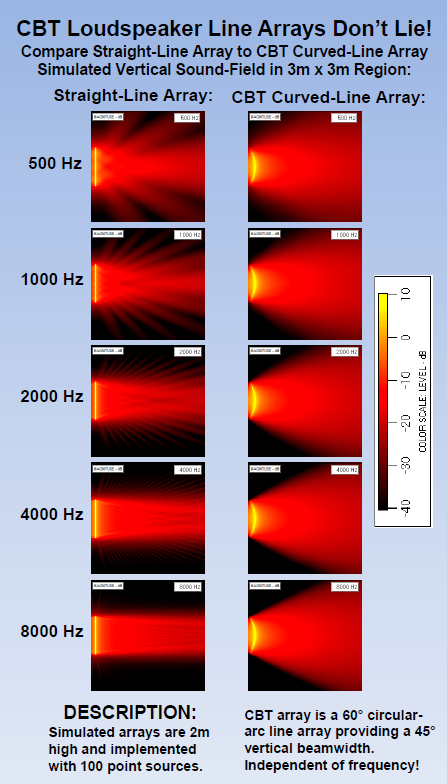Yes, and the focal point of the waveform is indeed at the floor.

not just that, there is more - the sound radiated by the floor level speakers is the loudest and the earliest reaching the listener
yet the sound is not coming from the floor
I think floor to ceiling straight array is better, no floor and ceiling reflections, and the sound is allways coming from your ear height regardless sitting or standing.
- Elias
probably a floor to ceiling line source - like Beveridge - is best, but I am not so sure about a floor to ceiling straight array of discrete elements
yet the sound is not coming from the floor
How do we know that ? Maybe it is coming from the floor 😉
If the CBT waveform is really a circular arch focused from a point located at the floor, and if the sound would not be perceived as coming from the floor, it would mean we would not be able to perceive source elevation.
This is not the case since the sound from any point source placed at the floor and aimed to the listener is perceived as coming from the floor.
Then how is CBT different in perceptual sense ?
the sound from any point source placed at the floor and aimed to the listener is perceived as coming from the floor.
not when a ceiling is present
http://www.diyaudio.com/forums/multi-way/121385-loudspeakers-room-system-169.html#post3180924
maybe it's just better to fix speakers into ceiling right above listening position 🙂
because?
I believe that:
http://www.diyaudio.com/forums/multi-way/121385-loudspeakers-room-system-169.html#post3164641
Then how is CBT different in perceptual sense ?
It isn't. The CBT doesn't radiated much energy towards the ceiling. That's one of its main features, controlled vertical directivity. No secondary virtual height source is created. The ceiling reflection simply isn't strong enough.
not when a ceiling is present
http://www.diyaudio.com/forums/multi-way/121385-loudspeakers-room-system-169.html#post3180924
But CBT is no flooder, it has vertical beamwidth of only about +-22 degrees. It will not illuminate the ceiling in typical home listening room to provide a strong enough ceiling reflection to lift the image from the floor.

It isn't. The CBT doesn't radiated much energy towards the ceiling. That's one of its main features, controlled vertical directivity. No secondary virtual height source is created. The ceiling reflection simply isn't strong enough.
That's what I was saying 😀
CBT creates images coming from the floor ?
Put the CBT on it's side at ear height in the corner (maybe a bit in front of the back wall) with the bottom against the side wall, problem solved?
I had exactly the same thought about the CBT and it's floor centred wave front:
But the response of someone that heard it:
I had exactly the same thought about the CBT and it's floor centred wave front:
http://www.diyaudio.com/forums/newreply.php?do=newreply&p=3434738Trace back the origin of the sound and you end up on floor level. There is the acoustic center of your (virtual) point source.
That's why I said I would hang it from the ceiling. But I'd rather have a 60 degree version floating between the ceiling and the floor (if you have the space)
But the response of someone that heard it:
Maybe in theory, but it never sounded that way to me.
Last edited:
I believe that approach radiates too much energy into the room.
I had always thought that the purpose of a speaker was to radiate energy into the room. 🙂
But CBT is no flooder, it has vertical beamwidth of only about +-22 degrees. It will not illuminate the ceiling in typical home listening room to provide a strong enough ceiling reflection to lift the image from the floor.
yes indeed 🙂 and what follows from that fact proves my point exactly!
You might ask how so?
here is how:
How do we know that ? Maybe it is coming from the floor 😉
contrary to any "theoretical" expectations I know of no single report of any sound coming from the floor phenomenon with CBTs
why? to answer that it suffices to answer to Your question:
Then how is CBT different in perceptual sense ?
one important thing is perceptually absent - the floor reflection
and this seems to confirm that I was right about the causes of the low image in case of Snell Type One - it wasn't the problem of "too much of the direct sound", it was the problem of the floor reflection of the midwoofer sound
Last edited:
I had always thought that the purpose of a speaker was to radiate energy into the room. 🙂
Sure but not into angles that only increase the level of the indirect field without adding anything beneficial (like increased spaciousness). A reflection free zone and low masking level isn't easy to achieve in a small room.
and this seems to confirm that I was right about the causes of the low image in case of Snell Type One - it wasn't the problem of "too much of the direct sound", it was the problem of the floor reflection of the midwoofer sound
I don't think so, since the proposal to correct the too low image was to raise the tweeters at the ear level.
I don't think so, since the proposal to correct the too low image was to raise the tweeters at the ear level.
but raising the tweeters at the ear level introduces a new elevation cue, absent before, and which is strong enough to override any cues from midwoofer and lower frequencies
the problem of the original Snell Type One was that the only elevation cue created by the speaker configuration resulted from the midwoofer sound floor reflection
the problem of the original Snell Type One was that the only elevation cue created by the speaker configuration resulted from the midwoofer sound floor reflection
while in the flooder approach speaker configuration creates no elevation cues of itself, therefore only those elevation cues that are preserved in the recording are audible
ps. and it creates no distance cues of itself either
Last edited:
Elias, have You tried up-firing speakers with the direct sound blocked ie. virtual ceiling speakers?
while in the flooder approach speaker configuration creates no elevation cues of itself, therefore only those elevation cues that are preserved in the recording are audible
ps. and it creates no distance cues of itself either
Sound wavefront emanating from a point located at the floor is an elevation cue essentially -> the sound is coming from the floor. HRTF will reveal that.
By blocking the direct sound and having a strong ceiling reflection lifts the image upwards towards ceiling. Again HRTF.
There must be a fine balance of floor and ceiling reflected sound, and propably direct sound too, in order to have image at realistic elevation somewhere in the vertical middle.
If there are multible almost simultaneous reflections from floor and ceiling (and walls), HRTF elevation cues does not seem to work but image is a huge and tall cloud. It seems that in order to have only elevation cues of the recording audible, we would need to eliminate room contribution.
- Elias
Sound wavefront emanating from a point located at the floor is an elevation cue essentially -> the sound is coming from the floor. HRTF will reveal that.
By blocking the direct sound and having a strong ceiling reflection lifts the image upwards towards ceiling. Again HRTF.
There must be a fine balance of floor and ceiling reflected sound, and propably direct sound too, in order to have image at realistic elevation somewhere in the vertical middle.
You said that:
In my monoflooder test the speaker was facing the ceiling. In that case I could not locate the speaker.
Then I tried to turn the speaker facing the listening area, and immediately the speaker was localisable or the sound was coming from the floor.
Have You considered what happened exactly when You turned the speaker towards the listening area?
because You said that:
It was a normal 2-way 12 l box with 1" dome tweeter and 6.5" bass.
so do You really think that what changed after You had turned it towards the listening area was the "fine balance of floor and ceiling reflected sound, and propably direct sound too"?
Could be this fairly typical two-way speaker with 1" dome tweeter that You used for Your test so atypically directional? 😕
[reposted]
interesting discussion:
A round table about room acoustics, and bass traps.
Mr Peter Lyngdorf:
it was I believe the Archimedes project led by Bech
floor reflection
floor reflection
floor reflection
interesting discussion:
A round table about room acoustics, and bass traps.
Mr Peter Lyngdorf:
I’ve done a lot of testing on the effects of reflections in rooms, and there was a big, big project in Denmark about twelve years ago, with a lot of companies involved in investigating effects of reflections in rooms. I had the pleasure of being a test person, where we could actually simulate the audible effect of the floor reflection, sidewall reflection, ceiling reflection, and so on independently. The single most disturbing reflection in the room is the floor reflection. That is what makes the speaker sound like a radio and not like the actual event. ... The floor reflection absolutely must be handled
it was I believe the Archimedes project led by Bech
floor reflection
floor reflection
floor reflection
Last edited:
- Home
- Loudspeakers
- Multi-Way
- The Advantages of Floor Coupled Up-Firing Speakers